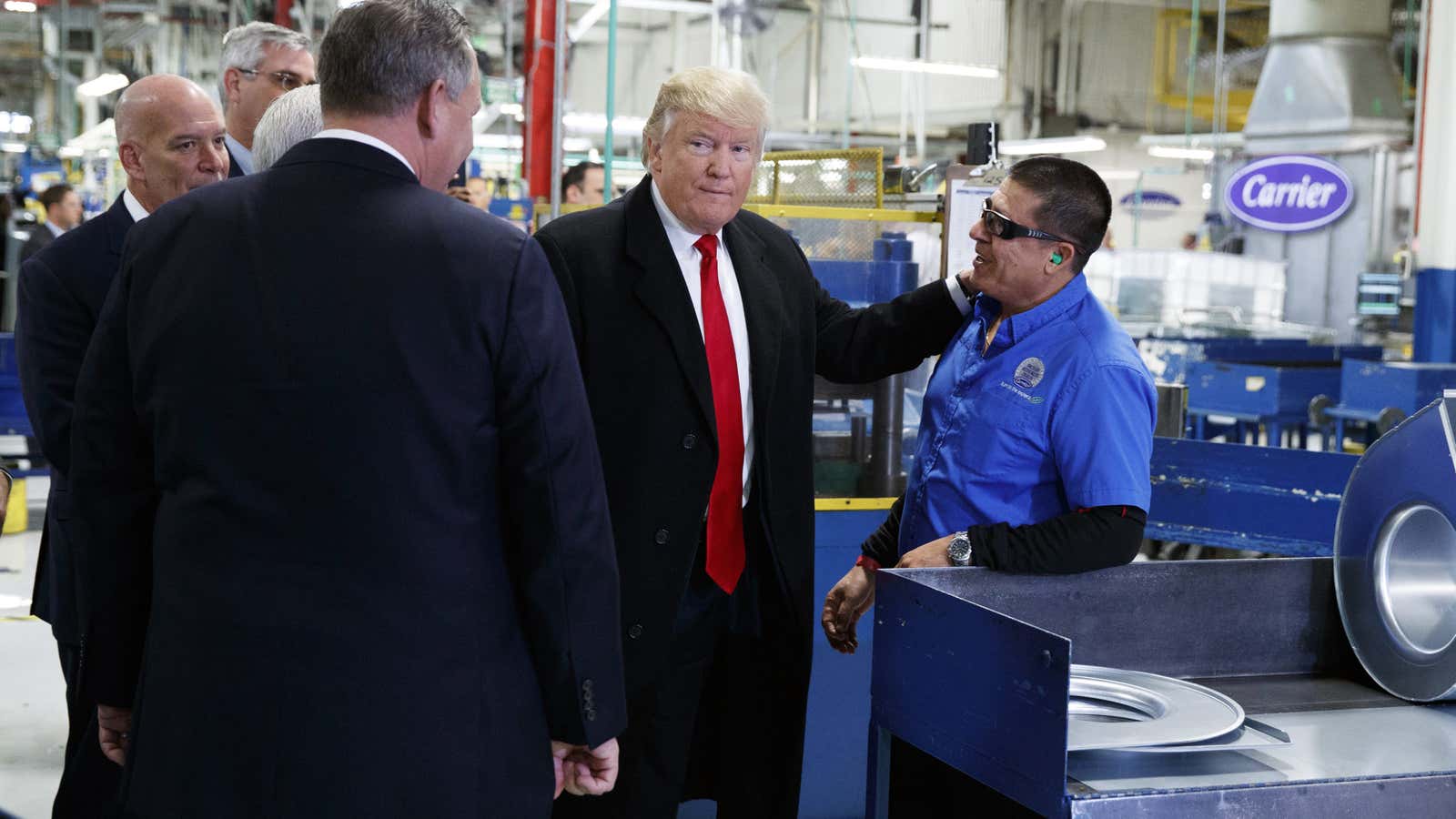As the story goes, Donald Trump won the US presidency because he promised good manufacturing jobs to blue-collar workers and a repudiation of economic globalization that many blame for hollowing out the US economy. Anecdotes in the media showed disaffected, white rural workers upset over the loss of their jobs championing Trump (and pillorying Hillary Clinton).
Economist Caroline Freund of the Peterson Institute for International Economics, thought something didn’t add up about this story. She noticed that Trump actually thrived in many towns where the economy was booming, like Elkhart County, Indiana, with low unemployment, strong exports, plenty of manufacturing jobs, and big benefits from Obama-era recession stimulus and auto bailout packages. The county went heavily for Trump (64.1% compared to 31.7% for Clinton) in 2016.
So Freund dug deeper into the data, and compared the voting patterns in the 2016 election to those in 2012, when Republican presidential nominee Mitt Romney lost to Democratic incumbent Barack Obama. If counties with high concentrations of manufacturing jobs rallied to Trump in 2016, it would suggest ties to the manufacturing economy fueled Trump’s success.
Freund found no such correlation. After analyzing election results, as well as economic and demographic data from the US Census Bureau, she concluded in a Peterson Institute analysis published this month (pdf) that “manufacturing employment or manufacturing job loss had no significant role in the overall election.”
What was significant in blue-collar counties? Race and education. These two factors account for about 80% of the so-called “Trump Effect,” or swing states’ support for Trump compared to Romney, according to Freund’s analysis.
That pattern was clear in the demographics of the counties that had the biggest voting shifts from 2012 to 2016. Trump’s biggest gains compared to Romney in 2012 were in counties with populations that were on average 98% white and where 8% held college degrees. Clinton’s biggest gains came in those with a population that was on average 85% white and where 48% held a college degree. On average, however, the share of manufacturing employment in both the Republican- and Democrat-moving counties was exactly the same: 7%.
Jed Kolk, the chief economist at the jobs site Indeed, points out that manufacturing is a thin slice of the total labor market. His analysis of the 2016 US election shows that Trump won counties where “routine” jobs from sales to clerical work were most threatened by technology or globalization. This, Kolk says, suggests economic anxiety may have helped fuel Trump’s support (although the analysis could not entirely isolate economic factors from other explanations).
The primacy of cultural issues in national politics has been growing since the 1960s. Then, many voters in the south and midwest switched their party affiliation to Republican for reasons believed to align with their cultural identity: opposition to the Civil Rights Act and support for the GOP’s embrace of evangelical Christians. In this most recent presidential election, matters like immigration shot up the rankings of critical issues, while the emphasis on the economy remained steady. The favorability of US trade policy actually improved in the minds of most American voters: 58% of Americans called trade an “opportunity” while 34% considered it a “threat,” compared to a 2012 poll showing opinions evenly split, reports Gallup (pdf).
“Cultural issues have replaced economic ones in their importance for electoral outcomes,” Freund argues. “I think the [2016] election was not about trade and manufacturing. It was about globalization in a different way, which is a sense of where America is in the world and a loss of identity that people seem to have…. It was much more about who we are…and where we’re going.”
That phenomenon is reshaping politics around the world, reports a Harvard Kennedy School of Government study, which found older, less-educated men are leading a backlash against cultural changes that “largely explains the rise of populist politics across the West.”
So what are political parties to do when besieged by polarization? Freund suggests the data imply parties should stop running polarizing candidates. Political scientists have long theorized (pdf) that polarization can be driven either by the electorate or by politicians themselves. In theory, voter turnout should rise in a polarized electorate—politically energized citizens, after all, should be eager to go to the polls. Polarizing candidates, by contrast, should have the opposite effect: unsatisfied moderate voters stay home given an unappealing slate of candidates. This second pattern, says Freund, was in evidence in 2016. ”Trump did not win the white working class, Clinton lost it,” writes Freund.
Freund’s advice is a tack to a sort of cultural middle—the centrist strategy France’s Emmanuel Macron rode to victory, and which seems to have played out in the most recent gubernatorial primary for the state of Virginia on June 12. Establishment forces won in both parties, reports the Washington Post, as voters rejected candidates on the far left and right.
For the first time, Virginia resident Curt Arledge, 32, cast a vote in a gubernatorial primary because, he argued, it was too important to miss. He chose current lieutenant governor Ralph Northam, a mainstream candidate with the endorsement of nearly every elected leader in the Democratic party, over his challenger, former congressman Tom Perriello championed by progressive leader, US senator Bernie Sanders.
Why? “I want to nominate Democrats who can get elected,” he said. Northam won the primary.
